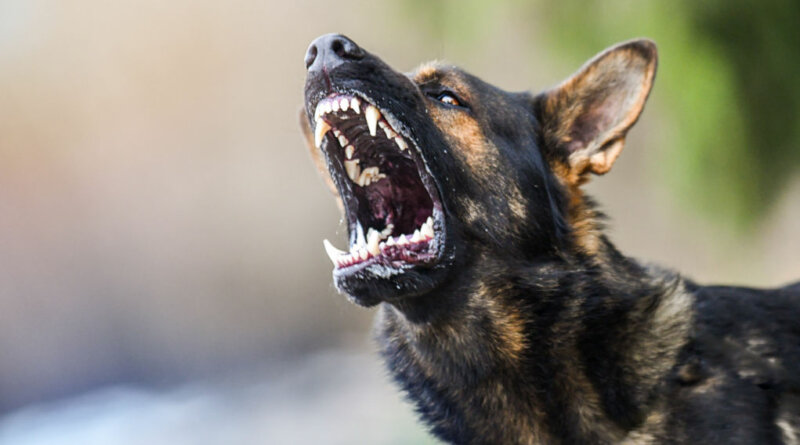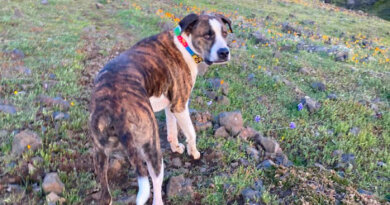How Can You Tell if a Dog is Aggressive – Top Dog Tips
How can you tell if a dog is aggressive?
The barking? The stalker-ish stance? The snarl?
Definitely, there are tell-tale signs that the dog across the street (or your dog, for that matter!) is getting aggressive.
However, it’s important to note that there are no inborn mean dogs. There may be underlying reasons that caused why dogs behave the way they do.
Good thing, there are sure ways how to calm an aggressive dog and how to stop dog aggression eventually.
In this article, let’s explore what are the signs of an aggressive dog, the different types of dog aggression, the reasons why dogs get aggressive, how to treat aggression in dogs, and, ultimately, how can you tell if a dog is aggressive.
How Can You Tell if a Dog is Aggressive?
Some breeds are stereotyped to be the “aggressive ones” compared with others, but that is not true at all!
According to a study that has been peer-reviewed by many animal experts, the situation in how dogs were raised is more indicative of whether they will be aggressive or not.
With that, instead of their breed, it’s best to pick up visual, physical, and verbal cues to spot when a dog is about to get aggressive.
Look out for these common signs so you can protect yourself and your loved ones from a possible vicious dog attack.
Visual Signs of Aggression in Dogs
- Stiff body posture; becoming very still and rigid
- Pinned back ears
- Bared teeth
- Crouching, lowering the body, or tucking the tail under the body
- Avoiding eye contact by squinting, turning the head, or body away from the threat
- Raised hackles
Physical Signs of Aggression in Dogs
- “Muzzle punch” (the dog literally punches the person with its nose)
- Repeated biting in rapid succession
- Bites of different intensities (from light snipping to puncturing bites)
Verbal Signs of Aggression in Dogs
- Barking that sounds threatening
- Growling
- Snarling
Reason Why Dogs get Aggressive
Being aggressive out of nowhere is uncommon for dogs.
Sure, all animals have their own aggressive tendency (even us, humans!), but there is always a reason why.
Sometimes, without even knowing it, we, the owners, become part of the cause of this behavior.
Below are just some of the ways we subconsciously make our own dogs aggressive.
How Do Owners Make a Dog Aggressive?
1. We don’t socialize them with others
Dogs that are not properly socialized tend to become aggressive when suddenly put in an unfamiliar environment.
They may feel scared, intimidated, and overwhelmed by the overload of stimuli a.k.a. strange creatures around them.
Their aggression is rooted in their lack of understanding about what things are and what should be the proper reaction to them.
2. We don’t make them feel safe
Fear aggression is common for dogs with traumatic experiences—rescued dogs, for example.
Because they were possibly abused or neglected in the past, they cope by using aggression to protect themselves.
They may take simple gestures like raising of hands as a sign that they are going to get hit, so they will get into defensive mode to prevent this from happening.
It’s important to assure them that they’re not going to get hurt anymore in your presence.
Gentle touch and affirmative words will help in calming their aggression and fear.
3. We restrain them for long periods of time
Our dogs get frustrated when they want something that they can’t get. This could be the cause of aggression in dogs that are always leashed or caged.
For example, they want to get their toys or food but can’t because of a barrier.
Or maybe, they saw the neighbor’s dog and feel like they are being challenged but can’t go near it because of, again, a barrier.
This could be a physical, literal barrier or a person or circumstance preventing them from getting what they want.
This frustration grows stronger and stronger the longer they are not able to address it.
4. We ignore warning signs of pain or discomfort
Pain can also be an underlying factor in why dogs suddenly become aggressive.
They may be sustaining an injury or illness that’s causing them discomfort but they just can’t say.
If your pet dog is suddenly displaying aggressive signs even towards you, try not to touch them just yet.
Assess their bodies by checking from a distance if they have any visible injury. Do they have an open wound? Are they limping?
If you can’t see any, it may be an internal injury or other illness that they feel inside.
However, don’t jump to a conclusion just yet! It’s best to consult your veterinarian first before doing anything.
5. We don’t provide them with safe spots
Dogs need safe spots where they can retire comfortably whenever they want.
It should house all the things that are important to them—food, toys, and even their babies.
Dogs tend to get aggressive when they feel like their territory is being invaded and their possessions are gonna be taken away from them.
With this, we also have to let other people know, especially visitors, to respect your dog’s safe spot to prevent them from displaying aggression to establish their dominance and possessiveness.
Types of Dog Aggression
Knowing the cause and the type of aggression a dog has is important to determine how to effectively address it.
From the list above of reasons why dogs get aggressive, here are the common types of dog aggression.
Territorial Aggression
This is where dogs get aggressive with an intruder—someone who they feel like a threat to their territory.
Protective/ Maternal Aggression
Because dogs are social creatures, they get protective of all the ”members” of their pack—be it their human owners, friends, or pups.
Possessive Aggression
Dogs are possessive as much as they are territorial. They protect their belongings like food and toys.
If they feel like someone will take their possessions, they will get aggressive.
Fear/ Anxiety Aggression
If a dog feels scared and cornered and the ‘flight’ option is not available anymore, it will most likely ‘fight’ and get aggressive.
Defensive Aggression
In defensive aggression, the dog can still be motivated by fear but it chooses to get offensive instead of retreat.
The warning signals of a scared and defensive aggressive dog might be different from the usual aggressive signs we see.
They may display submission in their body language but would still attack.
Social Aggression
Dogs follow a hierarchy; whoever the alpha always has to be the first.
If this was suddenly not followed, then the alpha might show aggression to the others.
Frustration or Redirected Aggression
A dog who wants something but can’t get to it because of a barrier might display aggression.
This barrier could be a lease, a cage, or even another animal or person.
Sometimes, the dog’s frustration-elicited aggression may be redirected to the ‘barrier’.
Pain-Related/ Irritable Aggression
Dogs can get irritable when they’re in pain. Because they can’t express what pains them or causes them discomfort, they might get aggressive instead.
Sex-Related Aggression
Dogs that are ready to mate with the opposite sex can get aggressive if there’s a possible threat or a competitor around.
This happens for both male and female dogs. Spaying or neutering your dogs (especially if you’re not trying to breed them!) will help in managing sex-related aggression.
Predatory Aggression
Dogs still have the natural predatory instinct. They might display aggression towards smaller, prey-like creatures or any fast-moving things like running people.
Unlike other types of aggression, predatory aggression typically doesn’t have any warning signals before it happens. They will just attack or run after their target.
Social Conflict-Related Aggression
While dogs are more likely to get aggressive toward strangers, they can also display aggression toward a familiar person or animal.
This may be brought about by any internal conflict that the dog has witnessed or experienced in the past.
How to Stop and Treat Dog Aggression
To be honest with you, treating dog aggression may be quite a difficult and challenging feat.
The aggressive behavior may be reduced in intensity and frequency, but there’s no guarantee that it will be ‘cured’ all the way.
But with the help of the experts, there may be ways to calm your aggressive dog and manage its hostility.
Consult with the experts
The best thing to do is to consult with experts. First with a veterinarian, then a board-certified animal behaviorist.
If there are no visible signs of injury to your dog, the vet may run some tests to check for a possible internal illness.
Depending on the diagnosis of the vet, your dog may also be given medication for a short period of time.
This medication may help them manage their anxiety, fear, or stress that’s possibly causing the aggression.
However, if any possible medical reason has been ruled out, you may be referred to a board-certified animal behaviorist.
They will help you determine other possible causes of aggression and how to address them by creating a plan on how to slowly teach new behaviors to your dog through positive reinforcement.
Use positive reinforcement training
It is important to do positive reinforcement training by giving treats, calming words, and praises to encourage them out of their aggressive behavior instead of using punishment.
Remember that it is important not to meet aggression with aggression!
If you try to hit your dog for growling or barking at strangers, the next time it feels uncomfortable, it may just attack without warning because it learned that it could get chastised if it started with a growl or a bark.
Additional Support
At some point, you may also want to assess your lifestyle–does it fit with the needs of your dog who is just learning how to manage its aggression?
Remember that throughout their treatment, it’s best to reduce, if not eliminate their triggers.
Can you continue providing its needs and sticking to the plan to help it get over stress and anxiety?
Your full support, patience, and love for your fur baby is the topmost thing it needs in these challenging times.
How to Prevent Dog Aggression
You may be noticing that your dog’s aggression is mostly triggered by the same stimuli over and over again.
Some of the most common objects of their aggressive behavior are another dog, a smaller animal, children, and sometimes, even family members.
Check out these ways to prevent your pet from being aggressive:
Dog Aggressive With Another Dog
Dog aggression with other dogs usually happens when two dogs (especially alpha dogs) who are unfamiliar with each other cross paths.
One important thing to remember is to distract them.
Block their view of the other dog as much as you can, and try to lead them the other way (if you’re not trying to make them friends.)
But if you want them to be friends, set it at your dog’s pace-don’t rush them.
One good trick is walking both dogs side by side (not head-on!) until they get accustomed to each other’s presence.
Dog Aggressive with Cat/Other Animals
It’s natural for dogs to want to chase after smaller creatures like cats.
But further aggression can be prevented even if both are not used to the other animal’s presence.
This is where your dog’s behavioral training will come in handy. The first time they encounter a cat, immediately redirect your dog’s attention to you.
Play with them and give them treats.
Just make sure to use positive reinforcement to let them know that they are doing well by ignoring the cat.
Dog Aggressive with Children
Because kids don’t necessarily have control over their actions, they may hurt or irritate the dog unknowingly.
This unpleasant experience may be the cause of why some dogs are aggressive toward children.
It’s important to prevent this early on during a puppy’s socialization stage.
Familiarize them with a child’s touch and presence so they will learn how to behave around one.
If you have a child in the family, you shouldn’t do anything with your dog that you don’t want them to do with the child, like roughhousing.
But if your dog’s aggression around children gets difficult to manage, remove them from the situation immediately before something serious happens.
Dog Aggressive with Family Members
There are many reasons why your dog feels aggressive toward a certain family member. There may be a history there that you just don’t know yet.
It’s possible that your dog (especially rescue dogs) is associating your family member with a trauma they experienced in the past.
It could also be a form of protective, possessive, or redirected aggression.
An assistive device like a muzzle may help you manage your dog’s aggression in the beginning.
While in this, have the family member be the “good cop.” Let them give the dog food, toy, or anything that shows they mean well.
But remember to not force your dog to behave and stop growling. Don’t chastise or hit them.
Remove them from the situation if it becomes harder to manage instead. It will also help to ask the family member to respect your dog’s safe space.
If the dog’s aggression doesn’t show any sign of improvement, seek the help of an animal behaviorist.
FAQs on How To Tell If A Dog Is Aggressive
How do you test a dog for aggression?
There are several organizations that offer temperament tests for dogs like the American Kennel Club, American Temperament Test Society, and other facilities.
Usually, the dog will undergo different activities like exploring unfamiliar places with different stimuli, such as a stranger in a threatening manner.
At what age do dogs become aggressive?
To tell you the truth, there is no one answer to this question as it depends on the temperament and the environment of the dog.
Generally, social aggression in dogs is observed around 1 to 3 years old. However, there are circumstances where an older dog can get aggressive (usually due to pain or illness).
How do you discipline an aggressive dog?
There are ways to discipline an aggressive dog without using punishment.
Redirect their attention, exhaust their pent-up energy by playing, and most importantly, use positive reinforcement.
Punishment, shouting, spanking, or showing them any sign of aggression may just aggravate their existing behavioral problem.
Can a dog become aggressive for no reason?
There is always a reason why a dog becomes aggressive.
It could be the sudden change in the environment, pain or discomfort they are feeling, or a threat they are perceiving.
Knowing the cause of your dog’s sudden aggression is key to addressing it as soon as possible.
How Can You Tell if a Dog is Aggressive: Summary
Being able to tell if a dog is aggressive is important not just for dog owners but for everyone.
It’s important to familiarize yourself with the usual signs of an aggressive dog so they can be addressed immediately.
Also, another important thing is learning the reasons why dogs get aggressive because they may just need extra help and attention from you.
Know that with proper ways and assistance to treat dog aggression, plus your patience and effort, your dog can maximize its true potential as your and your family’s best friend.
READ NEXT: How To Discipline a Dog Effectively Without Punishment
Related







